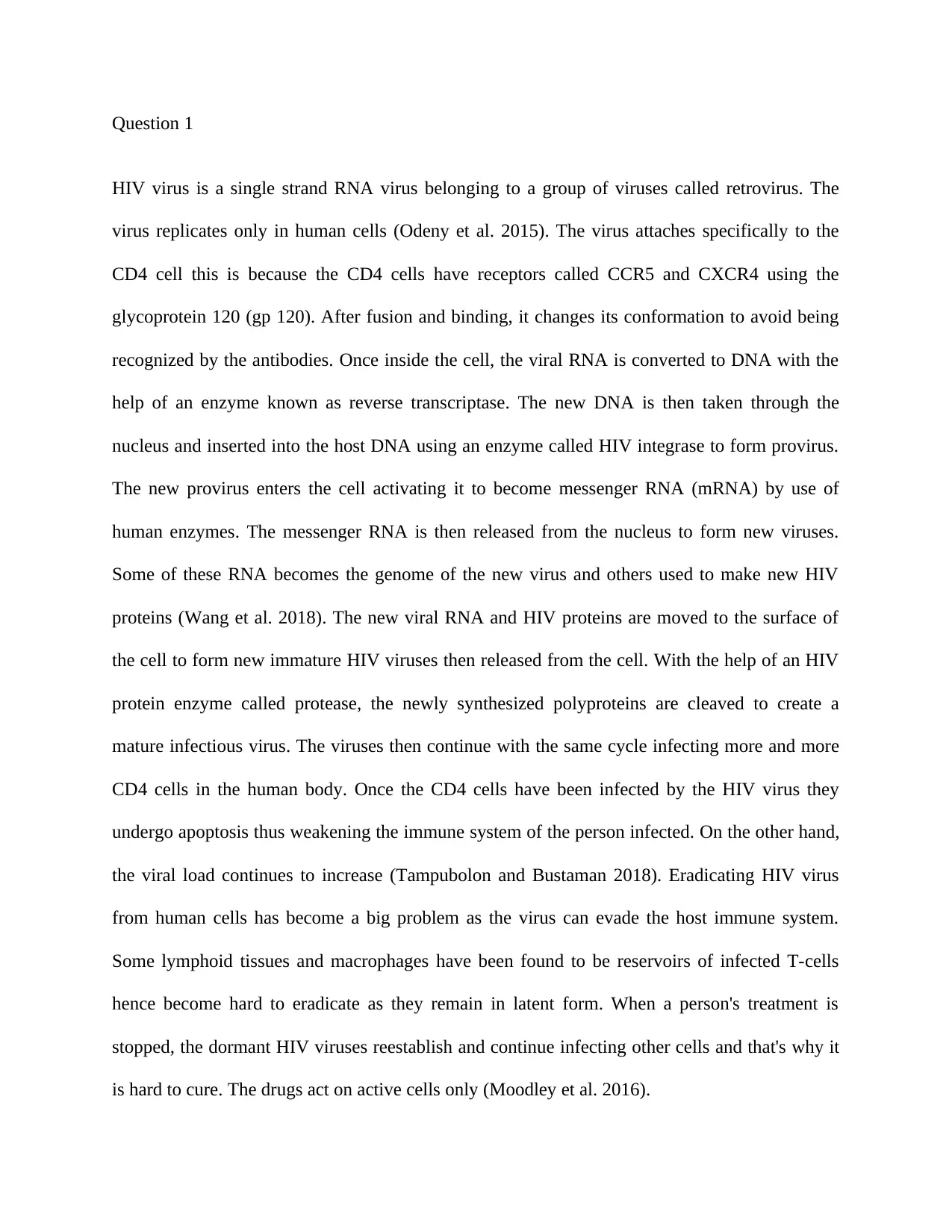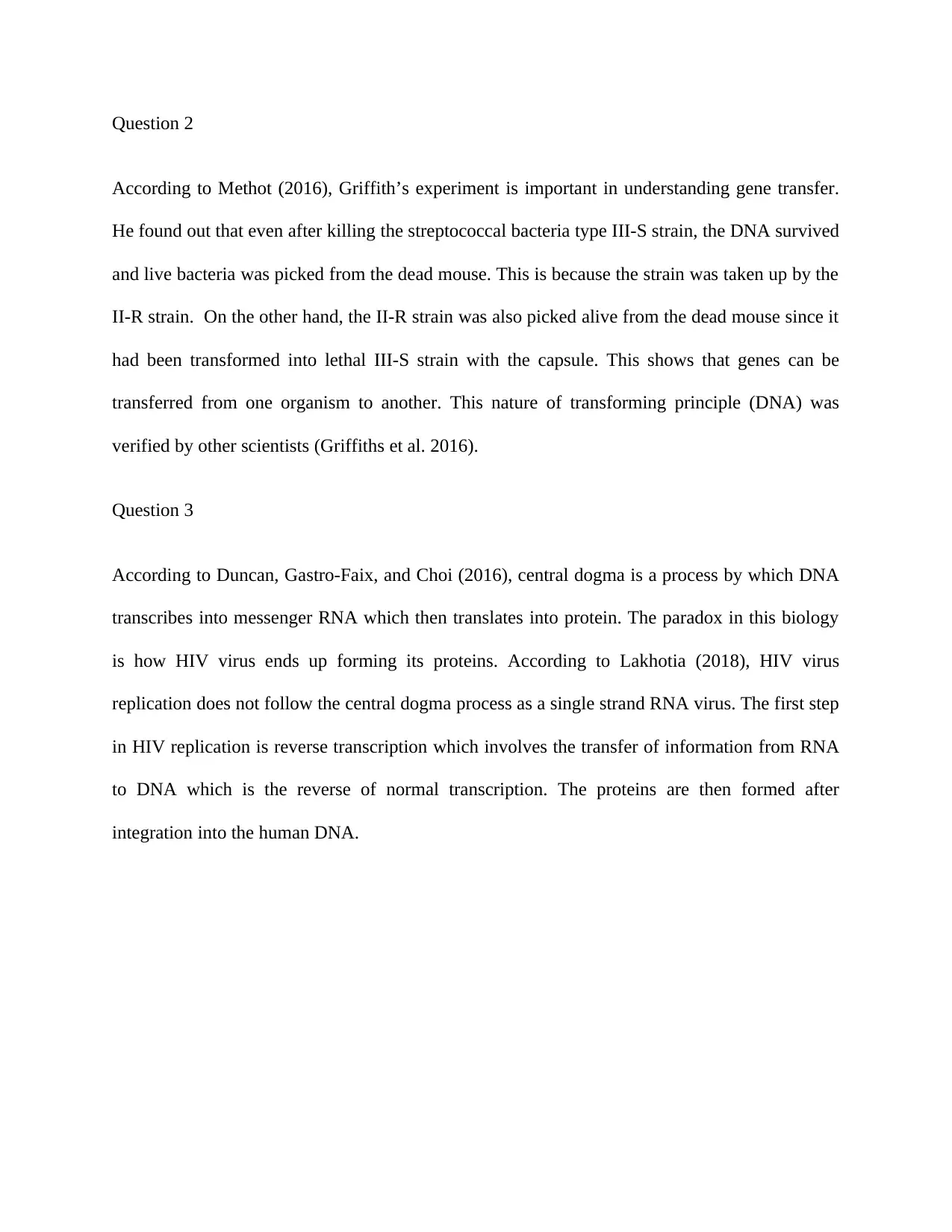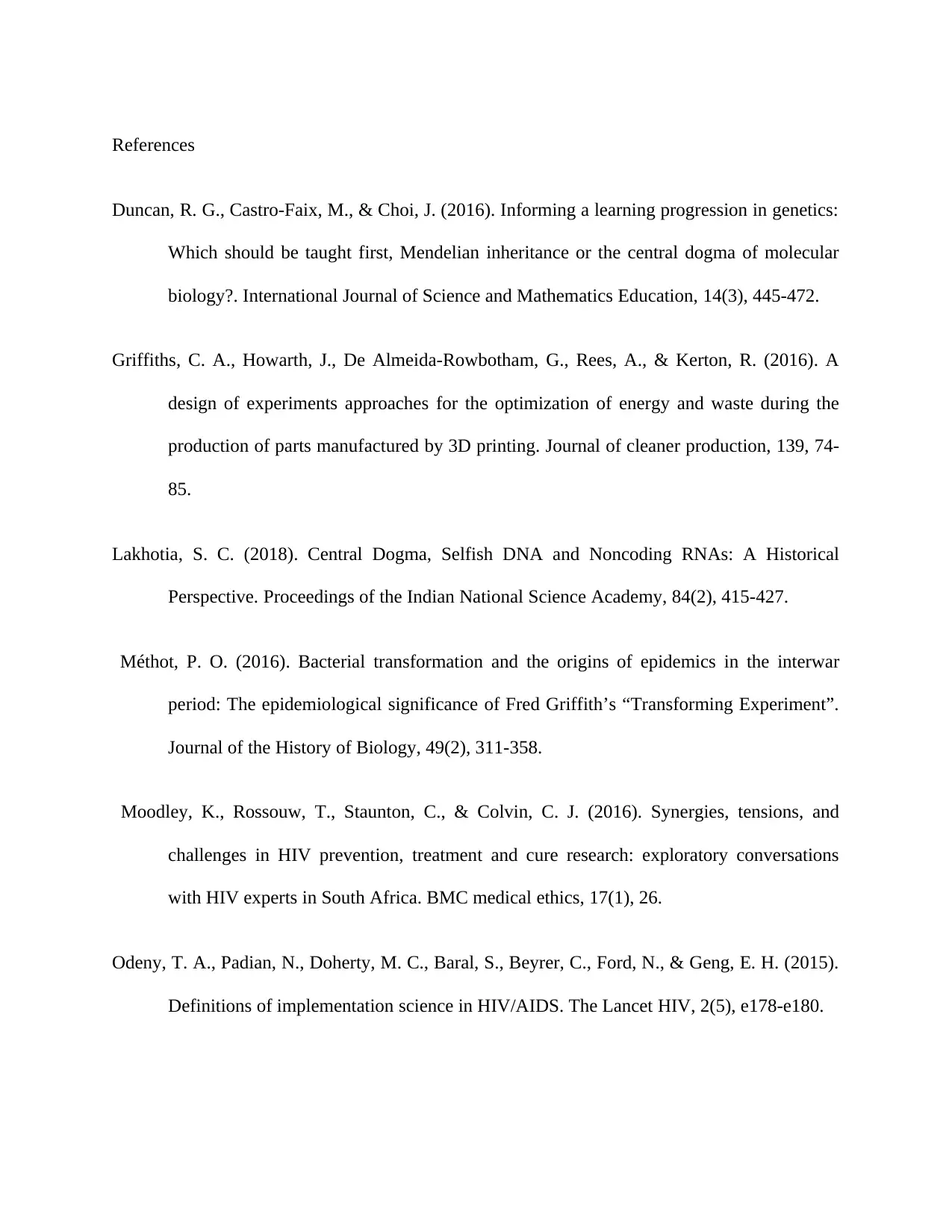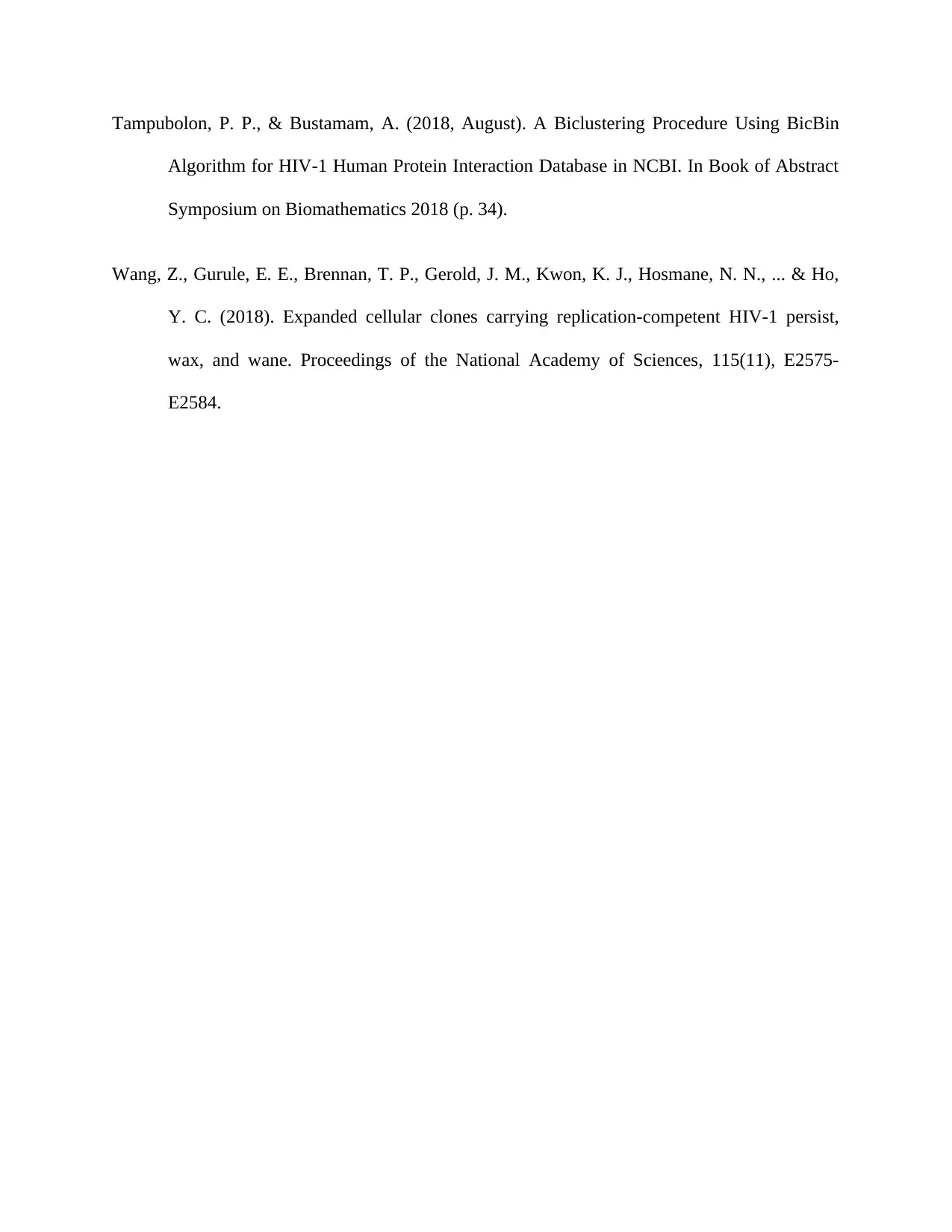Microbial Genetics Essay Questions for Biology Course, Spring 2019
VerifiedAdded on 2023/04/07
|4
|827
|356
Homework Assignment
AI Summary
This document provides detailed answers to three essay questions on microbial genetics. The first question explains the HIV virus's replication cycle, its impact on the immune system, and the challenges in finding a cure due to its ability to evade the host immune system. The second question discusses the significance of Griffith's experiment in demonstrating microbial gene transfer, highlighting how genetic material can be transferred between organisms. The final question addresses the central dogma of biology and its paradox in the context of HIV replication, which involves reverse transcription, a process that reverses the normal flow of genetic information from RNA to DNA. The document includes references to support the answers provided.

Question 1
HIV virus is a single strand RNA virus belonging to a group of viruses called retrovirus. The
virus replicates only in human cells (Odeny et al. 2015). The virus attaches specifically to the
CD4 cell this is because the CD4 cells have receptors called CCR5 and CXCR4 using the
glycoprotein 120 (gp 120). After fusion and binding, it changes its conformation to avoid being
recognized by the antibodies. Once inside the cell, the viral RNA is converted to DNA with the
help of an enzyme known as reverse transcriptase. The new DNA is then taken through the
nucleus and inserted into the host DNA using an enzyme called HIV integrase to form provirus.
The new provirus enters the cell activating it to become messenger RNA (mRNA) by use of
human enzymes. The messenger RNA is then released from the nucleus to form new viruses.
Some of these RNA becomes the genome of the new virus and others used to make new HIV
proteins (Wang et al. 2018). The new viral RNA and HIV proteins are moved to the surface of
the cell to form new immature HIV viruses then released from the cell. With the help of an HIV
protein enzyme called protease, the newly synthesized polyproteins are cleaved to create a
mature infectious virus. The viruses then continue with the same cycle infecting more and more
CD4 cells in the human body. Once the CD4 cells have been infected by the HIV virus they
undergo apoptosis thus weakening the immune system of the person infected. On the other hand,
the viral load continues to increase (Tampubolon and Bustaman 2018). Eradicating HIV virus
from human cells has become a big problem as the virus can evade the host immune system.
Some lymphoid tissues and macrophages have been found to be reservoirs of infected T-cells
hence become hard to eradicate as they remain in latent form. When a person's treatment is
stopped, the dormant HIV viruses reestablish and continue infecting other cells and that's why it
is hard to cure. The drugs act on active cells only (Moodley et al. 2016).
HIV virus is a single strand RNA virus belonging to a group of viruses called retrovirus. The
virus replicates only in human cells (Odeny et al. 2015). The virus attaches specifically to the
CD4 cell this is because the CD4 cells have receptors called CCR5 and CXCR4 using the
glycoprotein 120 (gp 120). After fusion and binding, it changes its conformation to avoid being
recognized by the antibodies. Once inside the cell, the viral RNA is converted to DNA with the
help of an enzyme known as reverse transcriptase. The new DNA is then taken through the
nucleus and inserted into the host DNA using an enzyme called HIV integrase to form provirus.
The new provirus enters the cell activating it to become messenger RNA (mRNA) by use of
human enzymes. The messenger RNA is then released from the nucleus to form new viruses.
Some of these RNA becomes the genome of the new virus and others used to make new HIV
proteins (Wang et al. 2018). The new viral RNA and HIV proteins are moved to the surface of
the cell to form new immature HIV viruses then released from the cell. With the help of an HIV
protein enzyme called protease, the newly synthesized polyproteins are cleaved to create a
mature infectious virus. The viruses then continue with the same cycle infecting more and more
CD4 cells in the human body. Once the CD4 cells have been infected by the HIV virus they
undergo apoptosis thus weakening the immune system of the person infected. On the other hand,
the viral load continues to increase (Tampubolon and Bustaman 2018). Eradicating HIV virus
from human cells has become a big problem as the virus can evade the host immune system.
Some lymphoid tissues and macrophages have been found to be reservoirs of infected T-cells
hence become hard to eradicate as they remain in latent form. When a person's treatment is
stopped, the dormant HIV viruses reestablish and continue infecting other cells and that's why it
is hard to cure. The drugs act on active cells only (Moodley et al. 2016).
Paraphrase This Document
Need a fresh take? Get an instant paraphrase of this document with our AI Paraphraser

Question 2
According to Methot (2016), Griffith’s experiment is important in understanding gene transfer.
He found out that even after killing the streptococcal bacteria type III-S strain, the DNA survived
and live bacteria was picked from the dead mouse. This is because the strain was taken up by the
II-R strain. On the other hand, the II-R strain was also picked alive from the dead mouse since it
had been transformed into lethal III-S strain with the capsule. This shows that genes can be
transferred from one organism to another. This nature of transforming principle (DNA) was
verified by other scientists (Griffiths et al. 2016).
Question 3
According to Duncan, Gastro-Faix, and Choi (2016), central dogma is a process by which DNA
transcribes into messenger RNA which then translates into protein. The paradox in this biology
is how HIV virus ends up forming its proteins. According to Lakhotia (2018), HIV virus
replication does not follow the central dogma process as a single strand RNA virus. The first step
in HIV replication is reverse transcription which involves the transfer of information from RNA
to DNA which is the reverse of normal transcription. The proteins are then formed after
integration into the human DNA.
According to Methot (2016), Griffith’s experiment is important in understanding gene transfer.
He found out that even after killing the streptococcal bacteria type III-S strain, the DNA survived
and live bacteria was picked from the dead mouse. This is because the strain was taken up by the
II-R strain. On the other hand, the II-R strain was also picked alive from the dead mouse since it
had been transformed into lethal III-S strain with the capsule. This shows that genes can be
transferred from one organism to another. This nature of transforming principle (DNA) was
verified by other scientists (Griffiths et al. 2016).
Question 3
According to Duncan, Gastro-Faix, and Choi (2016), central dogma is a process by which DNA
transcribes into messenger RNA which then translates into protein. The paradox in this biology
is how HIV virus ends up forming its proteins. According to Lakhotia (2018), HIV virus
replication does not follow the central dogma process as a single strand RNA virus. The first step
in HIV replication is reverse transcription which involves the transfer of information from RNA
to DNA which is the reverse of normal transcription. The proteins are then formed after
integration into the human DNA.

References
Duncan, R. G., Castro-Faix, M., & Choi, J. (2016). Informing a learning progression in genetics:
Which should be taught first, Mendelian inheritance or the central dogma of molecular
biology?. International Journal of Science and Mathematics Education, 14(3), 445-472.
Griffiths, C. A., Howarth, J., De Almeida-Rowbotham, G., Rees, A., & Kerton, R. (2016). A
design of experiments approaches for the optimization of energy and waste during the
production of parts manufactured by 3D printing. Journal of cleaner production, 139, 74-
85.
Lakhotia, S. C. (2018). Central Dogma, Selfish DNA and Noncoding RNAs: A Historical
Perspective. Proceedings of the Indian National Science Academy, 84(2), 415-427.
Méthot, P. O. (2016). Bacterial transformation and the origins of epidemics in the interwar
period: The epidemiological significance of Fred Griffith’s “Transforming Experiment”.
Journal of the History of Biology, 49(2), 311-358.
Moodley, K., Rossouw, T., Staunton, C., & Colvin, C. J. (2016). Synergies, tensions, and
challenges in HIV prevention, treatment and cure research: exploratory conversations
with HIV experts in South Africa. BMC medical ethics, 17(1), 26.
Odeny, T. A., Padian, N., Doherty, M. C., Baral, S., Beyrer, C., Ford, N., & Geng, E. H. (2015).
Definitions of implementation science in HIV/AIDS. The Lancet HIV, 2(5), e178-e180.
Duncan, R. G., Castro-Faix, M., & Choi, J. (2016). Informing a learning progression in genetics:
Which should be taught first, Mendelian inheritance or the central dogma of molecular
biology?. International Journal of Science and Mathematics Education, 14(3), 445-472.
Griffiths, C. A., Howarth, J., De Almeida-Rowbotham, G., Rees, A., & Kerton, R. (2016). A
design of experiments approaches for the optimization of energy and waste during the
production of parts manufactured by 3D printing. Journal of cleaner production, 139, 74-
85.
Lakhotia, S. C. (2018). Central Dogma, Selfish DNA and Noncoding RNAs: A Historical
Perspective. Proceedings of the Indian National Science Academy, 84(2), 415-427.
Méthot, P. O. (2016). Bacterial transformation and the origins of epidemics in the interwar
period: The epidemiological significance of Fred Griffith’s “Transforming Experiment”.
Journal of the History of Biology, 49(2), 311-358.
Moodley, K., Rossouw, T., Staunton, C., & Colvin, C. J. (2016). Synergies, tensions, and
challenges in HIV prevention, treatment and cure research: exploratory conversations
with HIV experts in South Africa. BMC medical ethics, 17(1), 26.
Odeny, T. A., Padian, N., Doherty, M. C., Baral, S., Beyrer, C., Ford, N., & Geng, E. H. (2015).
Definitions of implementation science in HIV/AIDS. The Lancet HIV, 2(5), e178-e180.
⊘ This is a preview!⊘
Do you want full access?
Subscribe today to unlock all pages.

Trusted by 1+ million students worldwide

Tampubolon, P. P., & Bustamam, A. (2018, August). A Biclustering Procedure Using BicBin
Algorithm for HIV-1 Human Protein Interaction Database in NCBI. In Book of Abstract
Symposium on Biomathematics 2018 (p. 34).
Wang, Z., Gurule, E. E., Brennan, T. P., Gerold, J. M., Kwon, K. J., Hosmane, N. N., ... & Ho,
Y. C. (2018). Expanded cellular clones carrying replication-competent HIV-1 persist,
wax, and wane. Proceedings of the National Academy of Sciences, 115(11), E2575-
E2584.
Algorithm for HIV-1 Human Protein Interaction Database in NCBI. In Book of Abstract
Symposium on Biomathematics 2018 (p. 34).
Wang, Z., Gurule, E. E., Brennan, T. P., Gerold, J. M., Kwon, K. J., Hosmane, N. N., ... & Ho,
Y. C. (2018). Expanded cellular clones carrying replication-competent HIV-1 persist,
wax, and wane. Proceedings of the National Academy of Sciences, 115(11), E2575-
E2584.
1 out of 4
Related Documents
Your All-in-One AI-Powered Toolkit for Academic Success.
+13062052269
info@desklib.com
Available 24*7 on WhatsApp / Email
![[object Object]](/_next/static/media/star-bottom.7253800d.svg)
Unlock your academic potential
Copyright © 2020–2025 A2Z Services. All Rights Reserved. Developed and managed by ZUCOL.





